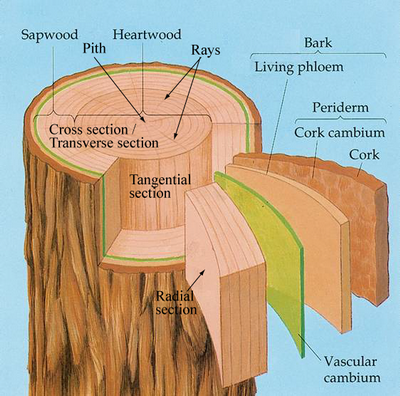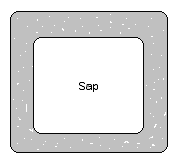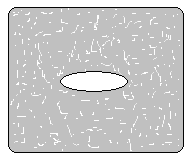The structure of wood (II)
Wood has extreme anisotropy because 90 to 95% of all the cells are elongated and vertical (i.e. aligned parallel to the tree trunk). The remaining 5 to 10% of cells are arranged in radial directions, with no cells at all aligned tangentially. The diagram below shows a cut-through of a tree trunk:

A cut-through of a tree trunk
In the trunk there are three main sections, the heartwood, which is physiologically inactive, the sapwood, where all conduction and storage occurs, and the bark, which protects the interior of the tree trunk. The two main types of tree, softwoods and hardwoods, have distinct internal structures. Coniferous trees are softwoods, with vertical cells, tracheids, 2 to 4 mm long and roughly 30 μm wide. These cells are used for support and conduction; they have an open channel and a thin cell wall:

Cross-section of tracheid cell typical of a softwood
The storage cells, parenchyma, are found in the radial direction. Scots pine is an example of a softwood tree. Below is shown a 3D model of the trunk interior of Scots pine made from micrographs of sections cut in the tangential, radial and transverse planes:
Broad-leaved trees are called hardwoods. The vertical cells in hardwoods are mainly fibres, which are 1 to 2 mm long and 15 μm wide. These are thick-walled with a very narrow central channel and are for support only.

Cross-section of fibre cell found in hardwoods
These cells are unsuitable for conduction, and so the tree needs vessels for this purpose. Vessels are either xylem, which are dead cells that carry water and minerals, or phloem, which are live cells and transport energy sources made by the plant. Vessels are 0.2 to 1.2 mm long, open-ended and are stacked vertically to form tubes of less than 0.5 mm in diameter. Hardwoods also have a small number of tracheid cells, and parenchyma cells are still present radially for storage. Both balsa and greenheart wood are examples of hardwoods. Below is shown a 3D model of the trunk interior of greenheart made from slides taken in the tangential, radial and transverse directions:

